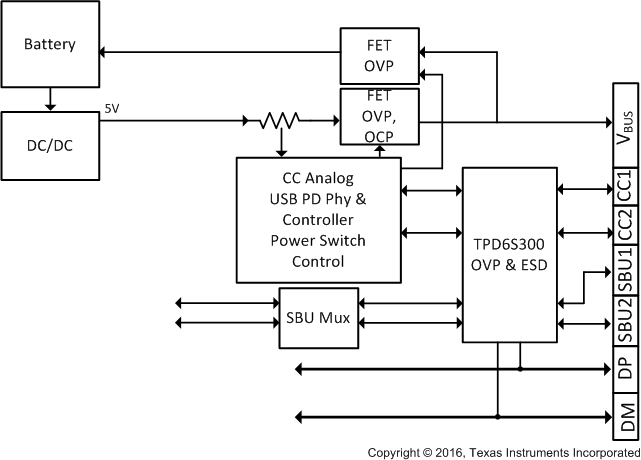ZHCSG02C September 2016 – January 2017 TPD6S300
PRODUCTION DATA.
- 1 特性
- 2 应用
- 3 说明
- 4 修订历史记录
- 5 Device Comparison Table
- 6 Pin Configuration and Functions
- 7 Specifications
-
8 Detailed Description
- 8.1 Overview
- 8.2 Functional Block Diagram
- 8.3
Feature Description
- 8.3.1 4-Channels of Short-to-VBUS Overvoltage Protection (CC1, CC2, SBU1, SBU2 Pins): 24-VDC Tolerant
- 8.3.2 8-Channels of IEC 61000-4-2 ESD Protection (CC1, CC2, SBU1, SBU2, DP_T, DM_T, DP_B, DM_B Pins)
- 8.3.3 CC1, CC2 Overvoltage Protection FETs 600 mA Capable for Passing VCONN Power
- 8.3.4 CC Dead Battery Resistors Integrated for Handling the Dead Battery Use Case in Mobile Devices
- 8.3.5 3-mm × 3-mm WQFN Package
- 8.4 Device Functional Modes
- 9 Application and Implementation
- 10Power Supply Recommendations
- 11Layout
- 12器件和文档支持
- 13机械、封装和可订购信息
1 特性
- 4 通道 VBUS 短路过压保护(CC1、CC2、SBU1、SBU2):24 VDC 容差
- 6 通道 IEC 61000-4-2 ESD 保护(CC1、CC2、SBU1、SBU2、DP、DM)
- CC1、CC2 过压保护 FET 600mA,能够通过 VCONN 电源
- 集成 CC 无电电池电阻器,可用于处理移动设备中的无电电池用例
- 3mm × 3mm WQFN 封装
2 应用
- 笔记本电脑
- 平板电脑
- 智能手机
- 监视器和电视
- 扩展坞
3 说明
TPD6S300 是一种单芯片 USB Type-C 端口保护解决方案,可提供 20V VBUS 短路过压和 IEC ESD 保护。
自从 USB Type-C 连接器发布以来,已经发布了很多不符合 USB Type-C 规格的 USB Type-C 的产品和配件。其中的一个示例就是仅在 VBUS 线路上布设 20V 电压的 USB Type-C 电力输送适配器。USB Type-C 的另一个问题是,由于此小型连接器中的各引脚极为靠近,因此连接器的机械扭转和滑动可能使引脚短路。这可能导致 20V VBUS 与 CC 和 SBU 引脚短路。此外,由于 Type-C 连接器中的各引脚极为靠近,所以存在碎屑和水汽导致 20V VBUS 引脚与 CC 和 SBU 引脚短路的严重问题。
这些非理想的设备和机械事件使得 CC 和 SBU 引脚必须具有 20V 容差,即使它们仅在 5V 或更低电压下工作。TPD6S300 通过在 CC 和 SBU 引脚上提供过压保护,可以使 CC 和 SBU 引脚实现 20V 容差,同时不会干扰正常工作。该器件将高压 FET 串联放置在 SBU 和 CC 线路上。当在这些线路上检测到高于 OVP 阈值的电压时,高压开关被打开,并且将系统的其余部分与连接器上存在的高压状态隔离。
最后,大多数系统都需要为其外部引脚应用 IEC 61000-4-2 系统级 ESD 保护。TPD6S300 为 CC1、CC2、SBU1、SBU2、DP、DM 引脚集成 IEC 61000-4-2 ESD 保护,并且无需在连接器上通过外部放置高压 TVS 二极管。
器件信息(1)
| 器件型号 | 封装 | 封装尺寸(标称值) |
|---|---|---|
| TPD6S300 | WQFN (20) | 3.00mm x 3.00mm |
- 如需了解所有可用封装,请参阅产品说明书末尾的可订购产品附录。
应用图表

4 修订历史记录
Changes from B Revision (November 2016) to C Revision
- Changed units from µs to ns for OVP_RESPONSE in the Timing Requirements tableGo
Changes from A Revision (September 2016) to B Revision
- 首次公开发布产品说明书Go